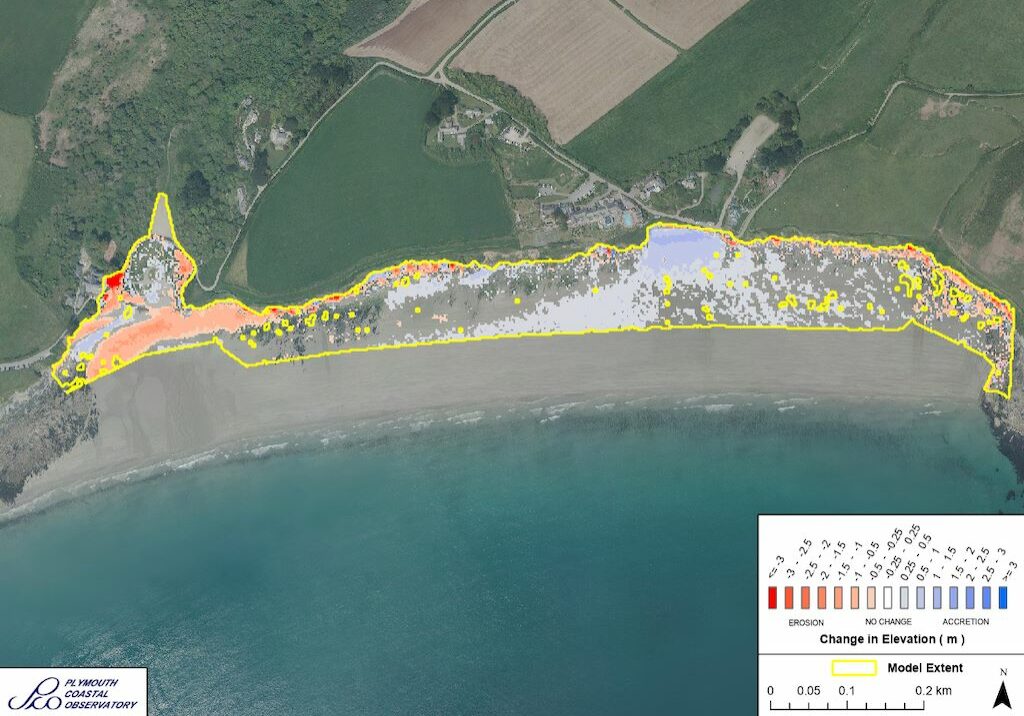
Pendower Beach (Cornish: Penardh, meaning ‘prominent headland’) is a wide south facing beach, within Gerrans Bay, located on the south coast of Cornwall. Two watercourses flow onto the beach, to the east runs a small unnamed stream and to the west the Trengrouse Stream. Both streams meander down steep sided and vegetated valleys.
The sediment on Pendower is coarse, with bands of shingle and has a grey colouration. To the east the beach is dominated by the prominence of Nare Head, whilst to the west a rocky platform, with a cliffline trending to the south and west, provides a more subtle beach boundary.
The rural setting is not significantly developed and the beach backed by a small dune system, a carpark and a steep sided wooded valley. The location is home to a number of historical features from a submarine forest buried under the sands of the beach, to a Second World War pillbox and walled features on the western edge of the beach.


Coastal Change
The coastline of Cornwall is an ever-changing environment. It is energetic, dynamic, never still and changes with each wave and each tidal cycle. Some of the changes we see are gradual and barely noticeable, whilst others, such as rockfalls, happen suddenly and often shockingly.
From one visit to the next it can sometimes be difficult to see how a beach and dune system has changed, but information has been collected, and is being collected through the Making Space for Sand project, to help us better understand how the coastline is changing. The purpose of this section of the website is to understand each location has changed over time, how it could change in the future and understand the policies that influence how we can respond to these changes.
Shoreline Management Plans (SMP)
The Shoreline Management Plan (SMP) is a strategic planning and management assessment tool that helps identify and measure the risk associated coastal erosion and coastal flooding. The document makes a number of policy recommendations over short, medium and long term timeframes setting out a strategic approach to managing the built, natural and historic environments associated with the coastline. Within SMP there are four policy approaches which have been assigned to stretches of coastlines. The four policies are: No Active Intervention (NAI), Hold the Line (HTL), Managed realignment (MR), and Advance the line (ATL).
Pendower sits within Policy Development Zone 4 (PDZ4), in Management Area 10 (MA10), within Policy Units (PU) 10.1, 10.2 and 10.3. The policy recommendations for these policy units are detailed in the table below and the SMP can be accessed through the Cornwall Council website.
Use your touchscreen
to scroll the below table
| Policy Unit | Policy Plan | ||||
| 2025 | 2055 | 2105 | Comment | ||
| 10.1 | Undefended cliffs & coves
Main Policy Sub Policy
|
NAI DnD
|
NAI DnD |
NAI DnD |
Very low levels of erosion on open cliffs and coves. Allow natural coastal evolution to occur to support conservation interest of protected sites. |
| 10.2 | Pendower East
Mail Policy Sub Policy
|
MR RnP |
NAI CtM
|
NAI NNtD |
Investigate options for realigning the local road to an alternative inland route to mitigate coastal squeeze, then allow coastal evolution to occur in the long term to maintain the nature conservation interest of the internationally important protected area and encourage a more natural shoreline. Implications for risk to parking areas and potentially one property will also need to be considered. The Nare Hotel is not considered to be at risk during the lifetime of the SMP.
|
| 10.3 | Pendower West
Main Policy Sub Policy
|
NAI LAO |
NAI LAO |
NAI LAO |
Allow dunes and beach to roll back and respond to coastal processes naturally, with no economic justification for defence and suitable alternative routes for access pathways. This approach does not preclude local works to defend the access road to the hotel as long as they do not interfere with natural dune and beach processes.
|
| Key Main Policy: HTL - Hold the Line, A - Advance the Line, NAI – No Active Intervention MR – Managed Realignment
Sub Policy: RnR – Repair not Replace, CtM – Cease to Maintain, NNtD – No need to Defend, LAO – Local Activity Only, MR – Maintain/Replace |
|||||


National Coastal Erosion Risk Mapping (NCERM)
The basic NCERM lines show erosion estimates for the Short Term (ST-20 years), Medium Term (MT-50 years) and Long Term (LT- 100 years). The data is further categorised by probability: 05 is 5% probability (a 1 in 20 chance of being exceeded) Red Shading, 50 is 50% probability of being exceeded (a 1 in 2 chance of being either exceeded or not exceeded) Orange Shading and 95 is 95% probability (a 19 in 20 chance of being exceeded) Yellow Shading. Click the link below to access the Cornwall Council NCERM Mapping site read the about section then click on layers.

Historical Image of Pendower
Historical photographs provide a powerful insight into how the Cornish coastline has changed within the past Century. The Making Space for Sand project are working in collaboration with the Francis Frith collection and have been given permission to share historical images on a number of beaches considered within the project.
In looking back, we can better understand how the coastline has changed, helping us understand not only how the coastal fringe has developed but also the potential future changes that we my observe. When this is considered alongside forecasts of coastal erosion and sea level rise it will help enable us to better adapt to our changing coastline.
Image of Pendower beach, c1955 (Courtesy of the Francis Frith collection) and in 2024.

Modelling Coastal Change

Using data that has already been collected, combined with data collected through the Making Space for Sand project, a series of models will be carried out at each location. This will help us better understand how each location may respond to sea level rise and gain a deeper understanding of how coastal sediments move and behave.
The complexity of the modelling, and the data collection that helps inform it, means that modelling outputs will not be the same on all sites. Some locations will be more thoroughly investigated to understand more complex issues and provide data that can be more widely applied to other sites with similar characteristics.
As the project develops this section of the website will expand, sharing new reports and coastal change projections when they are produced.
LiDAR surveys, which are explained on the Data Modelling page, have been carried out by the South West Coastal Monitoring program at this location. The image shared here visualises where sand has eroded (areas shaded in red) and where it has built up (areas shaded in blue), between the LiDAR surveys carried out in 1998 and 2019. The darker the shade of red or blue the greater the amount of sand erosion or accumulation has been observed. The image helps visualise that beaches are areas that change shape over time and will continue to do so as sea levels rise.



Beach and Dune Ecology
Beaches and dunes represent an important transition between the marine environment and the terrestrial environment. This transition creates a range of special habitats and exposes a range of interesting features, which that can result in these spaces being highly designated and protected. The Making Space for Sand project will survey a number of dune systems. These surveys will help highlight how they may be changing, will identify rare species, will map invasive species, help us understand overall dune condition and identify potential constraints to improving their condition.
There are a range of designations that recognise a variety of different features. There are also a number of dunes systems where data has been collected to understand their habitat value. These are explored, on a site-by-site basis, in the section below.

Designations
Special Area of Conservation (SAC)
A Special Area of Conservation (SAC) is an internationally recognised designation with the aim of protecting habitats or species that are of European importance. Land with SACs is considered to be part of a network of high-quality conservation sites, and those considered to be most in need of conservation at a European level.
The Fal and Helford SAC covers and area of approximately 6363 hectares. The sandbanks are biological rich and diverse with extensive areas of maerl (course shell) gravel. The sheltered estuaries associated with the SAC ae fringed with mudflats and sandflats that support rich and nationally important sediment communities. The rias (drowned river valley that remains open to the sea) of The Hel and Fal exposes the estuaries to the influence of the marine environment creating unique inlets and bays and narrow zonation between habitat types.
Image of a cormorant basking in the sun (Courtesy of Susan Scott)
Site of Special Scientific Interest (SSSI)
A Site of Special Scientific Interest or SSSI is a statutory conservation designation notified by Natural England denoting protection for biological and/or geological characteristics. The natural wildlife and geological features of SSSI’s are considered to be irreplaceable parts of the national heritage. These are protected in order to preserve their importance, and to prevent damage and development.
The Cuckoo Rock to Turbot Point SSSI covers an area of 102.5 hectares. Cuckoo Rock to Turbot Point is a stretch of coastline around Veryan Bay in Cornwall which demonstrates superb exposures of a highly complex geological terrain. Its interpretation is fundamental to studies of the geological evolution of south-west England.
Image of dune grasses growing at the toe of Pendower dunes
Designated Cornwall National Landscape Area
From November 2023, all areas previously know as Areas of Outstanding Natural Beauty, or AONBs, were re-named National Landscape and in Cornwall became Cornwall National Landscape. However, the Management Plan still references the term AONB as this was formally adopted by Cornwall Council and cannot be amended until the next plan is produced.
Cornwall National Landscape areas are protected landscapes whose distinctive character and natural beauty are so outstanding that it is in the nation’s interest to safeguard them. As such they have been nationally designated by the same legislation as National Parks and have the same status and level of protection.
The South Coast Central section covers 15,993 hectares, which is 16.6% of the total Cornwall National Landscape. The key landscape characteristic is a ridge which separates the Roseland from the Carrick Roads, consisting of a narrow strip of land barely half a kilometre wide between Zone Point and Gerrans Bay, broadens to include a stretch of varied and scenic coastland around Veryan Bay.
Image of the Portscatho coastline (Courtesy of Annette Anderson)
Special Protected Area (SPA)
A Special Protection Area (SPA) are areas of international importance for the breeding, feeding, wintering and migration of rare, threatened or vulnerable bird species.
The Falmouth Bay to St Austell Bay SPA covers the area of 258,98 hectares, below mean high water (MHW),between Nare Point and Gribben Head. The area qualifies for designation as it is regularly used by Annex I listed species including the Black-throated diver, the Great northern diver and the Slavonian grebe.

Beach Dune Management Plan
Many of the sand dunes and beaches around Cornwall’s coast are experiencing erosion and sediment loss. This is due, in part, to lack of new sediment input to the shoreline system and rising sea levels. This is a pressing concern as these environments provide protection against the risk of coastal flooding, provide important habitats that cannot be easily recreated elsewhere if lost and help support the regions thriving tourism industry. It is therefore vital that the sand dunes and beaches around Cornwall’s coast are managed in a more sustainable way that balances the combined functions of beach-dune system.
The Making Space for Sand project hope to develop a number of Beach Dune Management Plans, to complement those that have already been developed by Cornwall Council. It is anticipated that a BDMP will be developed for this location. The aim of the BDMP’s will be to:
- Identify the best day-to-day management approach in terms of monitoring and intervention for the beach and dune system.
- Provide a longer-term approach to beach and dune management based upon an up-to-date understanding of habitat condition, coastal processes at the site, as well as predictions of future coastal evolution.
If you are interested in providing information and data or want to share you knowledge of changes observed on a site where a beach dune management plan is being considered please make contact with the Making Space for Sand project using the email provided at the bottom of this page or on the Community Engagement page.
Sign up to Making Space for Sand
If you would like to get involved in helping to make dunes more resilient and biodiverse, want to help develop coastal adaptation and emergency plans or just want to know more about what the project is learning about coastal change, please click here:




